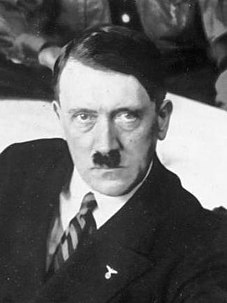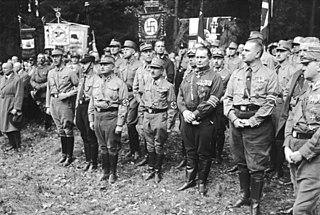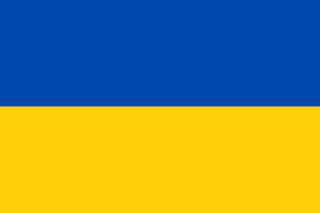
Bismarckjugend, 'Bismarck Youth', was an anti-Marxist youth movement in Weimar Germany. Bismarckjugend was the youth wing of the monarchist German National People's Party (DNVP).

Bismarckjugend, 'Bismarck Youth', was an anti-Marxist youth movement in Weimar Germany. Bismarckjugend was the youth wing of the monarchist German National People's Party (DNVP).
The organization was founded in Hanover in 1922, through the unification of various local youth groups close to DNVP. DNVP was the last of the established parties in the Reichstag to have a national youth wing of its own. The organization was politically completely dependent on the DNVP. The youth movement was initially led by Wilhelm Kube. Bismarckjugend branches were at first centred in the industrial areas of Germany. Later the movement spread its wings to the rural eastern regions of the country. [1] [2]
Soon after the founding of the national youth organization (in 1922), Hermann Otto Sieveking became its chairman. Under Sieveking's leadership, the organization developed a paramilitary character. It also began to organize annual national youth meetings. [1]
By mid-1923 Bismarckjugend entered a period of continuous decay. Generally DNVP was associated with the old order and was unpopular amongst the younger generation. [2]

In July 1928 the seventh national youth meeting of Bismarcksjugend has held in Friedrichsruh to commemorate the 30th anniversary of Otto von Bismarck's death. Friedrichsruh is the site of Bismarck's mausoleum. The meeting had particular importance to the mother party, as it was an important event to show strength after the meagre electoral result for DNVP in May the same year. [1] By the end of the 1920s Bismarckjugend had been revitalized and had expanded its membership. [2]
In the 1933 National Socialist take-over, parties other than the NSDAP either dissolved themselves or were banned. On June 27, 1933 a 'Friendly Agreement' was signed between the DNVP (renamed in 1932 into German National Front (DNF)) and the NSDAP, following which the DNF dissolved itself. [3] In 1935, the wearing of the Bismarckjugend uniform was banned by law. [4]
At the time of the founding of the organization, its name was National League of Youth Groups of the German National People's Party (Reichsverband der Jugendgruppen der Deutschnationalen Volkspartei). In the autumn of 1922 the name Bismarck Youth of the German National People's Party (Bismarckjugend der Deutschnationalen Volkspartei) was adopted, in short Bismarckjugend. [2] The name referred to Otto von Bismarck, and sought to link the organization with Bismarck's historical legacy. Bismarck's grandson Otto gave his permission to the organization to use his grandfather's name. [1]
Bismarckjugend organized men and women between the ages of 14 and 25. By 1928, the organization had 800 local organizations around Germany. Its total membership had reached 42,000, making it the second largest youth movement in the country at the time (after the SPD Socialist Worker Youth, Sozialistische Arbeiter-Jugend). Generally the movement had a stronger appeal in Protestant areas. Strongholds included Berlin, Magdeburg, Hesse, Thuringia, Lower Saxony, Pomerania, Württemberg and Hamburg. [1]
Most of the members came from bourgeois or noble families. However the single largest affiliate body of the movement, the Bismarck League Berlin, had an overwhelmingly working class membership. As of 1922 the Bismarck League Berlin had around 6,000 affiliates, approximately 80% from working-class families. The Berlin affiliate had been founded in 1920. [1]
Bismarckjugend published Deutsches Echo ('German Echo'). [1]

The German People's Party was a liberal party during the Weimar Republic that was the successor to the National Liberal Party of the German Empire. Along with the left-liberal German Democratic Party (DDP), it represented political liberalism in Germany between 1918 and 1933.

The German Democratic Party was a left-wing liberal party in the Weimar Republic. Along with the German People's Party, it represented political liberalism in Germany between 1918 and 1933. It was formed in 1918 from the Progressive People's Party and the liberal wing of the National Liberal Party.

Der Stahlhelm, Bund der Frontsoldaten, commonly known as Der Stahlhelm, was a German First World War veteran's organisation existing from 1918 to 1935. It was part of the "Black Reichswehr" and in the late days of the Weimar Republic operated as the paramilitary wing of the monarchist German National People's Party (DNVP), placed at party gatherings in the position of armed security guards (Saalschutz).

The Centre Party, officially the German Centre Party and also known in English as the Catholic Centre Party, is a Catholic political party in Germany, influential in the German Empire and Weimar Republic. Formed in 1870, it successfully battled the Kulturkampf waged by Chancellor Otto von Bismarck against the Catholic Church. It soon won a quarter of the seats in the Reichstag, and its middle position on most issues allowed it to play a decisive role in the formation of majorities.

The German National People's Party was a national-conservative party in Germany during the Weimar Republic. Before the rise of the Nazi Party, it was the major conservative and nationalist party in Weimar Germany. It was an alliance of nationalists, reactionary monarchists, völkisch and antisemitic elements supported by the Pan-German League.

The Frontier March of Posen-West Prussia was a province of Prussia from 1922 to 1938. Posen-West Prussia was established in 1922 as a province of the Free State of Prussia within Weimar Germany, formed from merging three remaining non-contiguous territories of Posen and West Prussia, which had lost the majority of their territory to the Second Polish Republic and Free City of Danzig in the Treaty of Versailles. From 1934, Posen-West Prussia was de facto ruled by Brandenburg until it was dissolved by Nazi Germany, effective 1 October 1938 and its territory divided between the Prussian provinces of Pomerania, Brandenburg and Silesia. Schneidemühl was the provincial capital. Today, the province is entirely contained within the modern state of Poland.
The Conservative People's Party was a short-lived conservative and Christian democratic political party of the moderate right in the Weimar Republic. It broke away from the German National People's Party (DNVP) in the late 1920s as a result of that party's increasing radicalization under the leadership of Alfred Hugenberg. Its leading figures were Kuno von Westarp, Hugenberg's predecessor as chairman of the DNVP, and Gottfried Treviranus, who would serve in the cabinet of Heinrich Brüning from 1930 to 1932. It was unable to make any significant breakthrough in the subsequent elections. The party did not take part in the 1932 parliamentary elections and ceased to be politically active before the NSDAP outlawed all other parties in Germany and established a dictatorship.
In the thirteen years the Weimar Republic was in existence, some forty parties were represented in the Reichstag. This fragmentation of political power was in part due to the peculiar parliamentary system of the Weimar Republic, and in part due to the many challenges facing German democracy in this period.
The early timeline of Nazism begins with its origins and continues until Hitler's rise to power.

Federal elections were held in Germany on 5 March 1933, after the Nazi seizure of power on 30 January and just six days after the Reichstag fire. Nazi stormtroopers had unleashed a widespread campaign of violence against the Communist Party (KPD), left-wingers, trade unionists, the Social Democratic Party of Germany, and the Centre Party. They were the last multi-party elections in Germany until 1946.

The Harzburg Front was a short-lived radical right-wing, anti-democratic political alliance in Weimar Germany, formed in 1931 as an attempt to present a unified opposition to the government of Chancellor Heinrich Brüning. It was a coalition of the national conservative German National People's Party (DNVP) under millionaire press-baron Alfred Hugenberg with Adolf Hitler's National Socialist German Workers' Party (NSDAP), the leadership of Der Stahlhelm paramilitary veterans' association, the Agricultural League and the Pan-German League organizations.
Organisation Consul (O.C.) was a nationalist-oriented and anti-Semitic terrorist organization that operated in the Weimar Republic from 1920–1922. The paramilitary O.C., led by Hermann Ehrhardt, was a regionally structured secret society that carried out political assassinations with the aims of destabilizing the democratic system of the republic, establishing a military dictatorship, and revising the end results of World War I, especially the Versailles Peace Treaty.

Otto Christian Archibald, Prince of Bismarck, was a German politician and diplomat, and the Prince of Bismarck from 1904 to his death.

The Free State of Brunswick was a state of the German Reich in the time of the Weimar Republic. It was formed after the abolition of the Duchy of Brunswick in the course of the German Revolution of 1918–19. Its capital was Braunschweig (Brunswick).
The Free State of Mecklenburg-Strelitz was a state of the Weimar Republic established in 1918 following the German Revolution which had overthrown the Grand Duchy of Mecklenburg-Strelitz. The state lasted until the Nazi Party (NSDAP) came to power in Germany and merged the state with the neighbouring Free State of Mecklenburg-Schwerin to form a new united state of Mecklenburg on December 31, 1933.
The Imperial Agricultural League or National Rural League was a German agrarian association during the Weimar Republic which was led by landowners with property east of the Elbe. It was allied with the German National People's Party and later the National Socialist German Workers' Party

Reinhold Wulle was a German Völkisch politician and publicist active during the Weimar Republic.
Reinhold Quaatz was a German conservative politician who was active during the Weimar Republic. Although associated with right-wing and völkisch tendencies, Quaatz was half-Jewish in ancestry.
Werner Küchenthal was a German jurist and public official who became a leading politician in what was then the Free State of Brunswick .
Herbert von Bismarck was a German lawyer and politician. In 1930 he switched to national politics, serving between 1930 and 1933 as a Member of the Reichstag in Berlin. He represented the conservative-nationalist DNVP (party). During a couple of months at the start of 1933 he served very briefly as secretary of state at the Prussian Interior Ministry before being placed in "temporary retirement". After the war he returned to public life between 1948 and 1952 as the first spokesman for the new Pommersche Landsmannschaft, an association created to represent the interests of those who had been expelled from their homes in Pomerania.